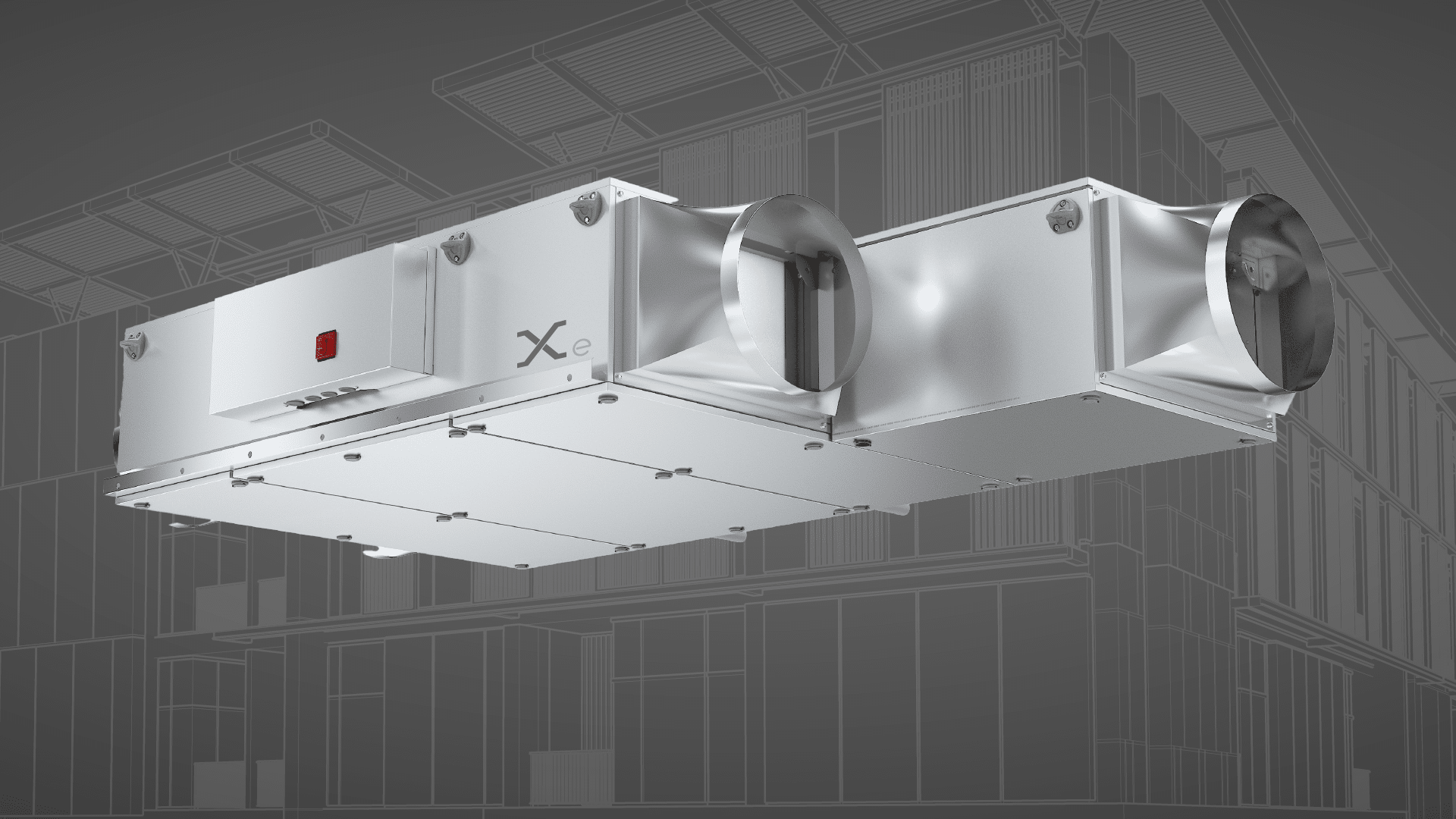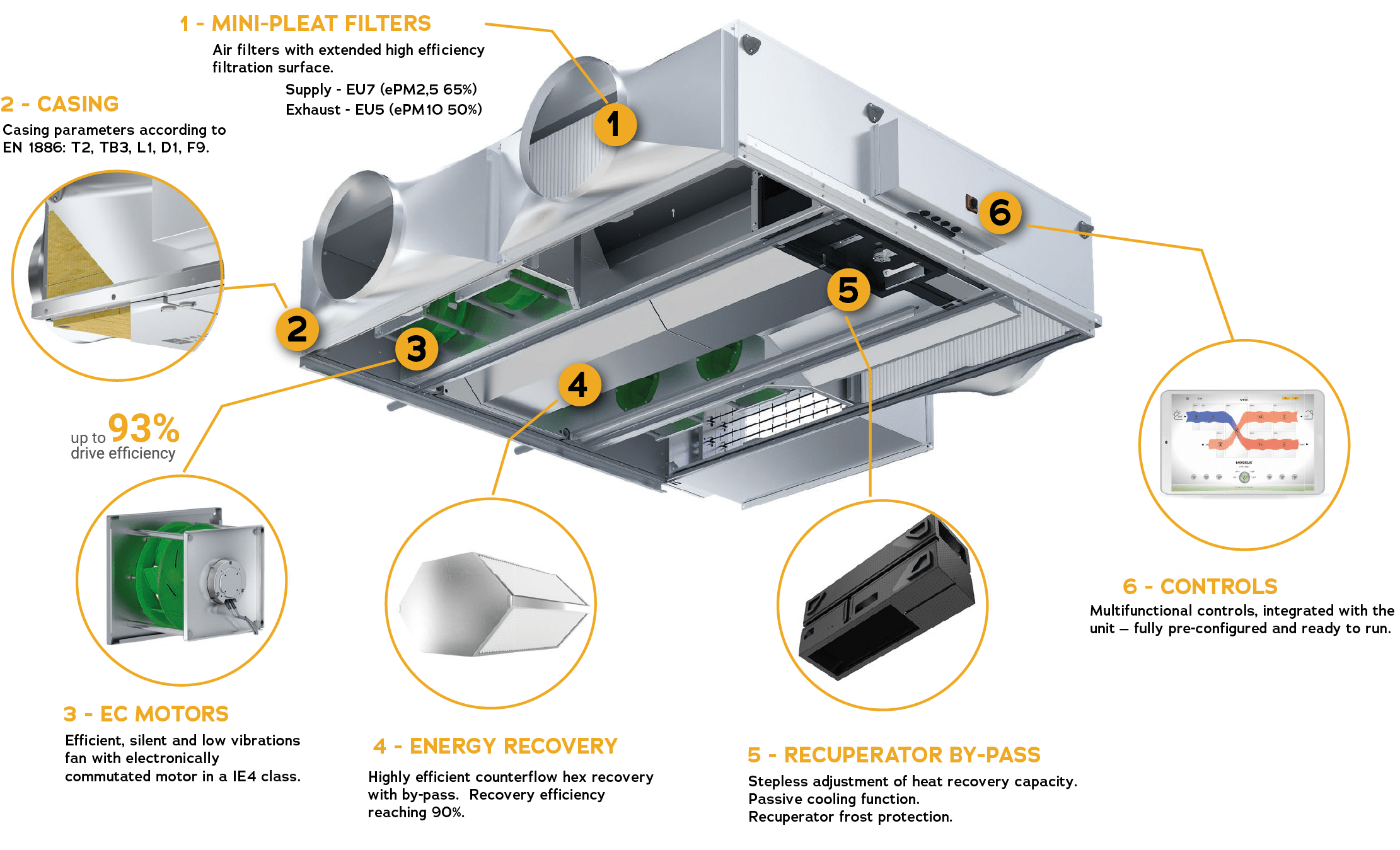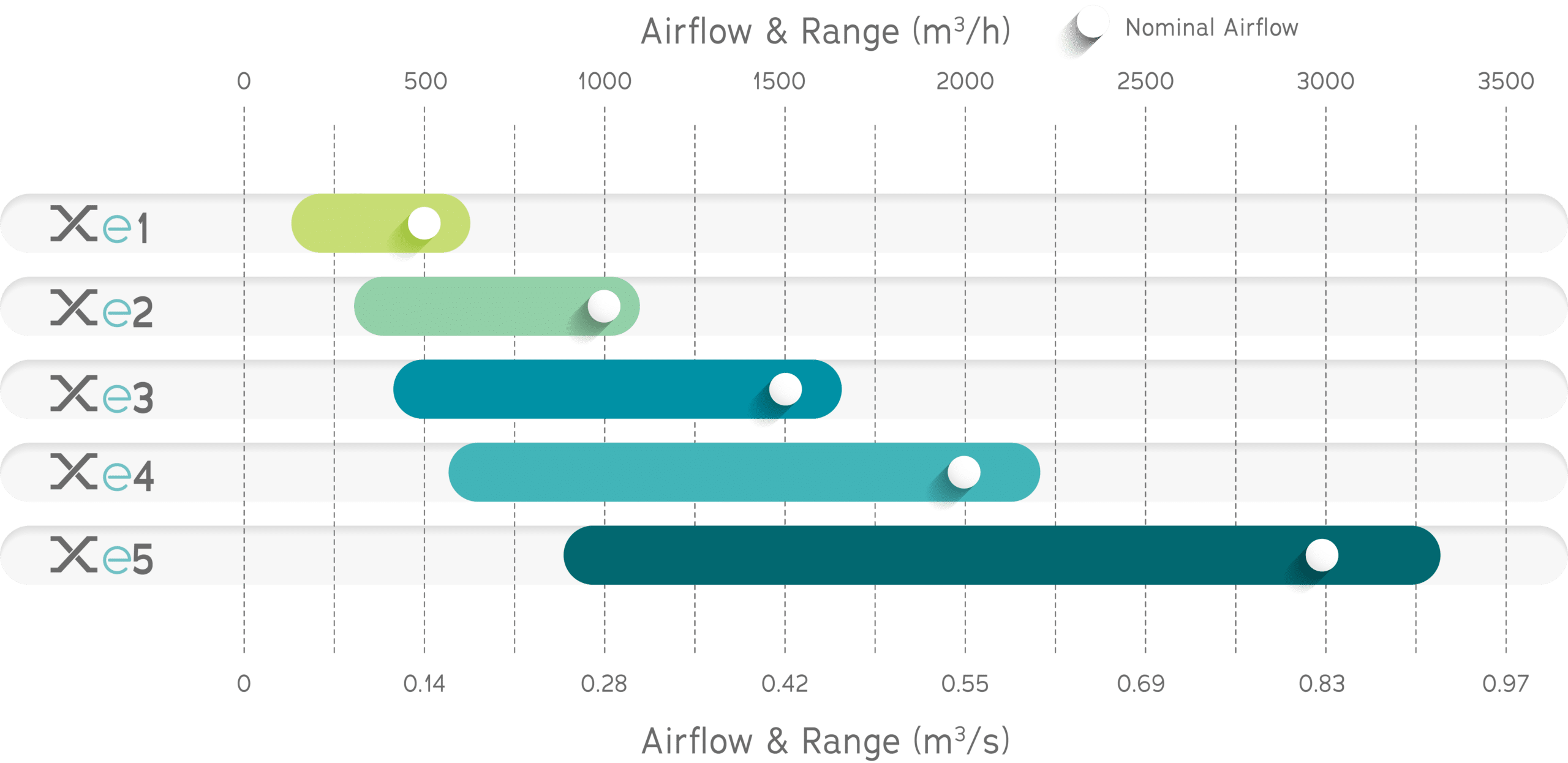What does MVHR stand for and does it have any other names?
MVHR stands for Mechanical Ventilation with Heat Recovery. Sometimes MVHR units are referred to as Heat Recovery Units (HRU’s) or Commercial Heat Recovery Units. The process is sometimes referred to as Heat Recovery Ventilation or comfort ventilation.
What is MVHR?
MVHR is a highly energy efficient ventilation unit that provides controlled ventilation within localised areas / rooms and as the name suggests, is dual purpose:
- Mechanical Ventilation: the extraction of stale indoor air containing pollutants, allergens, odours and humidity, and the introduction of fresh, filtered air from outdoors
- Heat Recovery: the recovery of otherwise wasted energy in the form of heat from extracted indoor air which is then used to heat the incoming fresh air as required.
Why do you need MVHR?
MVHR (Mechanical Ventilation with Heat Recovery) is the most energy-efficient ventilation system that maintains a high level of indoor air quality by continuously providing fresh filtered air and extracting the stale and polluted air from the area it serves.
The key feature of a MVHR system is that whilst extracting the warm stale air from the room, it recovers up to 95% of the heat energy used in heating the building and transfers it to the incoming fresh, yet cold, filtered air.
The intelligent solutions works both ways, on warm summer days, the extracted colder indoor air will cool the warm outside air to maintain a comfortable indoor air temperature.
MVHR systems are becoming the solution of choice within energy efficient and airtight buildings, as this helps to reduce the heating and cooling demands of a building and allow businesses to make valuable energy savings.
This renewable technology reduces the ongoing heating and cooling demand and carbon footprint of the building and is a major reason why Mechanical Heat Recovery Ventilation is being integrated into the ventilation system of energy-efficient buildings. MVHR also meets Part F of the building regulations which provides guidance on ventilation, air quality and preventing condensation in domestic or non-domestic buildings.
Does MVHR need to comply with any regulations?
Commercial MVHR units should be compliant with part L (vol 2) Building Regulations and also ErP Eco-design directive 2018 (non-residential) compliance. If used in schools, the unit should also achieve BB93 (minimum performance standards for acoustics) and BB101 (ventilation, thermal comfort and indoor air quality).
In addition, commercial units should also achieve performance levels as per BS EN 1886.
What are the benefits of MVHR?
Where can I find out more about Commercial Building Ventilation?
CIBSE (Chartered Institute of Building Services Engineers) is an international professional engineering organisation and is widely regarded as the standard setter and authority on building services engineering – it publishes guidance and codes which are internationally recognised and sets the criteria for best practice in the profession. Top tips about Ventilation in Buildings can be found here.
Where can you use MVHR?
MVHR installations can be found in all kinds of premises, ranging from light commercial and industrial workplaces such as offices, retail and hotels. Also very common in public buildings such as schools and hospitals. In all cases, the purpose is to ensure that the workplace (where we spend a great part of our lives), is comfortable and that the air we breathe is clean and is at the right temperature and humidity. The three most common applications for MVHR units are:
- Commercial buildings such as offices, retail and other public buildings
- Healthcare premises including hospitals, health centres and buildings dedicated to caring for vulnerable people such as care homes
- Educational establishments including schools, academies, universities and colleges
When should you use MVHR?
MVHR provide controlled ventilation with slow but constant air movements. In contrast, natural ventilation is a form of uncontrolled ventilation, which fluctuates with wind speeds, temperatures, internal obstructions, such as the opening or closure of internal doors, windows and vents. MVHR systems are therefore well suited to premises which have relatively good air tightness.
In addition, if a commercial property suffers from external noise, poor air quality, pollution, odours and humidity, MVHR systems can offer the perfect preventative solution.
How does MVHR work?
MVHR systems are relatively straightforward and basically consist of two fans (supply and extract) a plate heat (or cross-flow) heat exchanger and filter all connected to a simple ductwork system around the building.
The units are designed to extract moist, stale and polluted air which is then passed through the heat exchange cell to recover and retains energy in the form of heat that would otherwise be lost directly to the atmosphere. This heat is then transferred to incoming fresh, filtered air that the unit re-supplies back into the room, resulting in minimal heat losses and a more comfortable indoor environment. As an example, efficient systems can typically raise the temperature of cold outside air from 0ºC to 18ºC through the heat transfer, when the extract air is 20 ºC. Conversely, a cooling effect is achieved by a summer bypass.
The heart of the MVHR system is the heat exchanger, which transfers up to 90% of the heat from the extract air to the supply air (without both air streams mixing or physically touching). Unlike air conditioning, MVHR system do not re-cycle any air and the counter-flow or plate heat exchanger keeps both supply and extract air streams separate and therefore safe to operate in situations where the spread of viruses or pollutants needs to be controlled.
Choosing an MVHR System
The quantity of ventilation required depends on a number of factors, including the fresh air required for the number of people expected to be in the space, what they will be doing, the types of local heat sources such as lighting, small appliances and computers, any sources of pollutants in the space, and sources of humidity.
The rate of ventilation for an area is normally expressed in ‘air changes per hour’ i.e. the number of times per hour that the entire air volume of the area is changed. It is important to note that because of mixing in the room, it does not mean that all the original air is replaced with each air change.
Typical applications range between 5 and 15 air changes per hour and these correspond to different MVHR models all of which provide different airflows dependent upon customer requirements. Typical airflows range from 0.1 – 0.8m3/s or 200 – 3300 m3/h
Almost all MVHR units retain an element of customisability including:
- Different heating and cooling options LPHW / electric / cold water) plus DX option
- A variety of sensors including CO2, passive infrared (PIR) and temperature
- Choice of electrical controllers and HMI panels are normally available
- Options for additional noise control / attenuation
- Different levels of filtration depending upon unit location
What should you look for when considering an MVHR system?
The levels of heat / energy recovery of the MVHR units is normally high on the list of customer priorities, however there are a number of additional factors that should be taken into account when considering the suitability of different heat recovery units:
- Unit acoustics especially break-out noise should always be considered especially for use within schools, academies and universities.
- Energy efficiency – in addition to levels of heat recovery, the operational efficiency of the unit is key: high efficiency fans are critical in minimising energy use.
- Build quality – the construction of heat recovery units is an often-overlooked element and can significantly affect operational cost and unit performance levels. The lower the levels of air leakage and SFP’s the more economical the performance of MVHR units.
- Unit control configuration and flexibility, including integration with BMS, potential HMI interfaces and even the availability of BIM files / models should be considered.
- The availability of unit customisation is crucial to manufacture an MVHR unit for any application and environment. Optional extras can include: LPHW and electric heating coils, CO2 / PIR / Temperature sensors and pollen filters. Ease of maintenance through different access options and unit warranty should not be forgotten.
How and where do you install MVHR units?
MVHR units have been designed to keep the unit height to an absolute minimum (ranging from approximately 250 to 600mm. This would normally enable them to be located in the plenum space above a suspended ceiling. Alternatively, the absence of a dropped ceiling would necessitate the unit attachment as unobtrusive and high as possible to the ceiling level to allow maintenance access (good practice is to leave half unit width on both sides). The units pleasing aesthetic and associated small diameter ductwork may well add to the overall appearance and visuals of its selected location.
As an MVHR unit can be a heavy plant item, lifting should be via an overhead crane with a spreader beam and straps to ensure easy location with no damage. When positioning the unit, suitable bracketry and appropriate fixings are required for the weight of unit and the material being secured to. Internal MVHR units are designed to be able to be suspended from a ceiling using drop rod fixings and suitable bearers and brackets. Ductwork connected directly to the unit should be independently supported.
Wiring and electrical components should be connected by a qualified electrician and all wiring is installed to the latest edition of the IEE regulations.
Units are fitted with condensate traps and all pipework should be installed in accordance with local and national regulations, including Part H Drainage & Waste Disposal (UK).
Does MVHR need any ongoing maintenance?
Due to the relative simplicity of the units, very little maintenance should be required. Unit failure is very rare as it is only the fans which are classed as mechanical parts. Most is just low-tech maintenance including cleaning and filter replacement. Normal recommendations are to check the condition of the filter every quarter and change it if necessary. Inspections and servicing packages are available from many reputable sources and include:
- Checking for damage
- Checking load bearers
- Inspect fan impellors and clean
- Check for play in fan & motor bearings
- Inspect & clean coils as required
- Vent coils of any trapped air
- Check & clean drain trays & reprime
- Check all electrical connections
- Clean PHX and operation of bypass function
Mansfield Pollard offer this service as part of their maintenance packages.
How do you control MVHR units?
MVHR units come with a number of control options:
- No control – MVHR units simply has a on and off switch to control it.
- Demand Controlled – uses different sensors to increase speed and performance typically in relation to the amount of CO2 temperature or humidity levels. A PIR sensor may also be used (infra-red) to detect when someone is present to control the unit.
- BMS – It is possible to use BMS (Building management interface) to control the unit remotely or in a plant room.
Can MVHR be retrofitted?
In most cases some form of heat recovery systems can be retrofitted, however, there are several issues to consider before considering a heat recovery system:
- Is there space on the premises for a commercial heat recovery system? That’s not just for the ventilation unit but the ducting that must connect each of the rooms in the building.
- Is the new system simply replacing the old one or does a whole new infrastructure need to be installed?
- Can you integrate the new heat recovery unit with your existing systems?
Why are MVHR Systems becoming more popular for Commercial Buildings?
There are three main reasons why advanced ventilation solution such as MVHR are rapidly becoming the ventilation system of choice for businesses in the UK.








